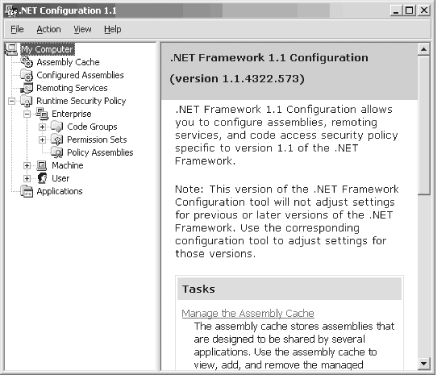XML-Based Configuration
You configure applications in .NET primarily through XML files. This is replacing previous, more cryptic stores such as the Windows registry or a database. If you are involved with .NET and are not yet familiar with XML, I recommend you purchase a good book to study it. All settings within the .NET Framework can be managed through XML configuration files, and the IIS metabase is moving in the same direction, too. I recommend Microsoft ASP.NET Setup and Configuration Pocket Reference (Microsoft Press). This work provides outstanding detail into the management of ASP.NET applications. It is a reference guide that covers ASP.NET along with a good amount of general .NET information.
Configuration Types
The .NET Framework defines two types of XML configuration files: Security Policy and Settings.
Security Policy
Security Policy files define the code access security policy, which specifies what type of actions code is allowed to perform. I will cover code access security in detail later in this chapter.
These files are far too big and ugly to display here. I strongly recommend using the .NET Configuration MMC, pictured in Figure 9-1, to administer these files.

Figure 9-1. .NET Configuration MMC
Settings
Settings files are probably the most exciting breakthrough in .NET from a management perspective. These files have consolidated all application settings into a single ...
Get Learning Windows Server 2003 now with the O’Reilly learning platform.
O’Reilly members experience books, live events, courses curated by job role, and more from O’Reilly and nearly 200 top publishers.

